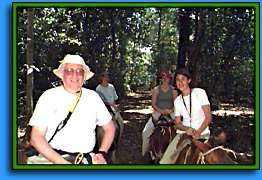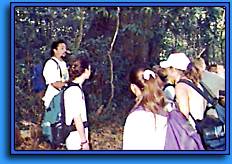| M a r t y ’ s J o u r n a l s
Tuesday, April 14
We left our lodge for the trail around 7:30 this morning. Almost immediately, we found ourselves in dense wet forest. Some of the trees were very large with huge buttress roots, like those you can see elsewhere on this web site. The students were much impressed with the strangler figs on many of the medium- to large-size trees. These figs sprout in the canopy and send roots down to the ground on several sides of the tree. Eventually the roots competely surround the original tree, strangling it out of existence. This is a spectacular sight to see! It’s debatable whether this is “parasitism” or just competition for light and space. I think of it as parasitism since the original tree is eventually killed. Marcos Soto, our naturalist guide, believes it’s simply competition for light and space. Perhaps it really is just a semantic argument, or maybe not.
Then later on the hike, we saw several birds of considerable interest since they are migrants who winter here in Costa Rica and then travel to New Jersey and other northeastern states for the summer. One of the most beautiful was the scarlet tanager. We were able to see both the yellow female and the scarlet colored male. In addition there was a black-throated green warbler and blackburnian warbler and a Swainson’s thrush. These birds make the annual migration back north about this time. They should be leaving around the same time as us, but I don’t think they will get “Frequent Flier” miles! So here’s a question for all who are reading this: Why do these birds fly north? Why don’t they simply stay here where it’s warm all year? I’ll post some answers on DISCUSS. -Marty Stickle. |
| Marty’s Journals
Arrival April 10, 1998 April 11, 1998 April 14, 1998 April 15, 1998 April 17, 1998 | Student Journals
Gwen R. Martha B. Brian D. Sarah F. Doug W. Allison T. Becky H. Sarah F. Tim B. |
![]()

 Besides the trees, we saw a number of interesting organisms. First, there
was a whole family of coatimundis. These racoon-like animals, about as large
as medium-sized dogs, have a long tail and are quite comfortable both in
the trees and on the ground. We saw a whole family troop of about 8-10
animals come down off a large tree and cross a stream right next to us.
Besides the trees, we saw a number of interesting organisms. First, there
was a whole family of coatimundis. These racoon-like animals, about as large
as medium-sized dogs, have a long tail and are quite comfortable both in
the trees and on the ground. We saw a whole family troop of about 8-10
animals come down off a large tree and cross a stream right next to us.